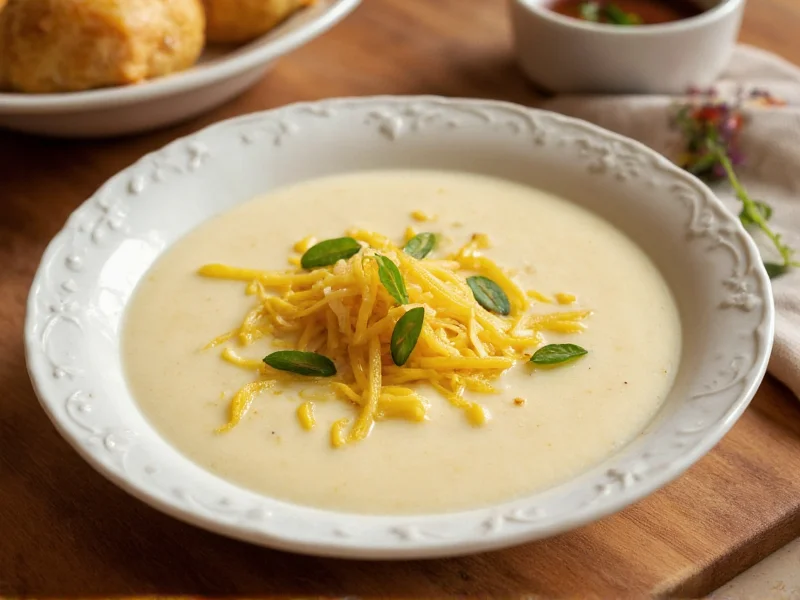The Ultimate Potato Soup: A Culinary Staple Done Right
Nothing comforts quite like a bowl of homemade potato soup, but achieving that perfect balance of creamy texture without becoming gummy or bland requires specific techniques. This comprehensive guide reveals professional kitchen secrets for making potato soup that impresses even discerning palates, whether you're preparing a quick weeknight meal or an elegant dinner party starter.
Why This Potato Soup Recipe Works
Most home cooks struggle with potato soup that turns out either too thin or unpleasantly thick. The difference between mediocre and magnificent potato soup lies in understanding potato varieties, proper starch management, and layering flavors. Russet potatoes provide the ideal balance of starch and moisture, while Yukon Golds add natural buttery notes. Combining both creates depth impossible with a single variety.
| Ingredient | Quantity | Professional Purpose |
|---|---|---|
| Russet potatoes | 2 lbs, peeled and diced | Provides structure and starch for natural thickening |
| Yukon Gold potatoes | 1 lb, peeled and diced | Adds buttery flavor and creamy texture |
| Yellow onion | 1 large, finely diced | Creates flavor foundation without overpowering |
| Garlic | 3 cloves, minced | Essential aromatic depth |
| Chicken or vegetable broth | 4 cups, low-sodium | Flavorful liquid base that won't overpower |
| Heavy cream | 1 cup | Creates luxurious mouthfeel (substitute with milk for lighter version) |
| Unsalted butter | 3 tablespoons | Superior flavor compared to oil for sautéing |
| All-purpose flour | 3 tablespoons | Creates smooth roux for proper thickening |
Step-by-Step Preparation Guide
Follow these professional techniques for foolproof potato soup every time:
- Sauté aromatics properly: Melt butter over medium heat (not high) and cook onions until translucent but not browned (8-10 minutes). Add garlic during the last minute to prevent burning.
- Create the perfect roux: Sprinkle flour over onions and stir constantly for 2 minutes until raw flour smell disappears but before browning occurs.
- Add liquid gradually: Slowly whisk in broth while maintaining constant stirring to prevent lumps. Bring to gentle simmer.
- Cook potatoes correctly: Add diced potatoes and simmer gently for 15-20 minutes until tender but not disintegrating. Overcooking causes mushiness.
- Texture refinement: Remove 1 cup of soup, blend until smooth, then return to pot. This technique creates creaminess without excessive cream.
- Final seasoning: Stir in cream, then adjust salt and freshly ground pepper. Finish with 1 tablespoon lemon juice or white wine vinegar to brighten flavors.
Common Potato Soup Variations
Adapt this base recipe to suit different dietary needs and flavor preferences:
- Bacon lovers version: Cook 6 oz chopped bacon first, use rendered fat for sautéing, and garnish with crispy bits
- Vegan adaptation: Substitute butter with olive oil, use vegetable broth, and replace cream with coconut milk
- Loaded baked potato style: Top with shredded cheddar, sour cream, chives, and crumbled bacon
- Herb-infused: Add 2 sprigs fresh thyme and 1 bay leaf during simmering, removing before serving
- Spicy kick: Include 1 diced jalapeño with onions and finish with hot sauce
Professional Tips for Perfect Potato Soup
Master chefs rely on these techniques to elevate potato soup from ordinary to extraordinary:
- Uniform dicing: Cut potatoes to exactly 1/2-inch cubes for even cooking. Irregular pieces lead to some being mushy while others remain undercooked.
- Temperature control: Never boil potato soup vigorously after adding dairy, as this causes separation and graininess.
- Seasoning progression: Salt in stages - a pinch when sautéing onions, more when adding broth, and final adjustment at the end.
- Acid balance: The small amount of acid (lemon juice or vinegar) at the end transforms flat flavors into something vibrant.
- Resting time: Let soup sit off heat for 15 minutes before serving. This allows flavors to meld and texture to stabilize.
Storage and Reheating Guidelines
Proper storage maintains quality for future enjoyment:
- Cool completely before refrigerating (within 2 hours of cooking)
- Store in airtight container for up to 4 days
- Freeze without dairy for up to 3 months; add cream when reheating
- Reheat gently over medium-low heat, stirring frequently
- Add splashes of broth or milk when reheating to restore proper consistency
Frequently Asked Questions
Can I make potato soup without dairy?
Yes, you can create a creamy dairy-free potato soup by using blended cauliflower or white beans as thickeners. Simply cook 1 cup of cauliflower florets with the potatoes, then blend with 1/2 cup of the soup before returning to the pot. For richer texture, add 1/2 cup of pureed cannellini beans near the end of cooking.
Why does my potato soup become watery after refrigeration?
Potato soup often separates when cooled because starches release water during refrigeration. To fix this, gently reheat while stirring constantly, and if needed, create a slurry with 1 tablespoon cornstarch mixed with 2 tablespoons cold water. Whisk this into the simmering soup until it reaches your desired consistency.
What's the best potato variety for creamy soup?
For optimal creamy texture, combine russet and Yukon Gold potatoes. Russets provide starch for natural thickening while Yukon Golds contribute buttery flavor and smooth texture. Avoid waxy potatoes like red potatoes, which maintain their shape too well and won't break down sufficiently for a creamy consistency.
How can I prevent my potato soup from becoming gluey?
Gluey texture occurs when potatoes are overworked or overcooked. To prevent this, avoid using a blender on the entire soup - instead, remove one cup, blend until smooth, then return to the pot. Also, never boil potato soup vigorously after adding dairy, as high heat causes starches to become gummy. Maintain a gentle simmer throughout cooking.











 浙公网安备
33010002000092号
浙公网安备
33010002000092号 浙B2-20120091-4
浙B2-20120091-4